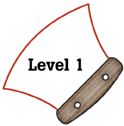
Alaska Science
Key Element C8
A student who meets the content standard should understand that acceptance of a new idea depends upon supporting evidence and that new ideas that conflict with beliefs or common sense are often resisted.
 |
Alaska Science A student who meets the content standard should understand that acceptance of a new idea depends upon supporting evidence and that new ideas that conflict with beliefs or common sense are often resisted. |
|
Performance Standard Level 1, Ages 5–7
|
|
|
|
Sample Assessment Ideas
|
|
|
Expanded Sample Assessment Idea
|
|
Procedure Students will:
Reflection and Revision
|
Levels of Performance |
||
|
Stage 4 |
Student participates fully, makes accurate observations, demonstrates mastery of concepts and skills, clearly describes and communicates findings, and relates conclusions to other processes and concepts. Student participates fully in class discussion, clearly describes and communicates findings and concludes the activity without evidence of misconceptions regarding the volume of water. | ||
|
Stage 3
|
Student participates substantially, makes largely accurate observations, understands the concepts and skills, and effectively describes and communicates findings and conclusions. Student participates in class discussion, describes and communicates findings but may conclude the activity with minor misconceptions regarding the volume of water. | ||
|
Stage 2
|
Student participates, makes observations, grasps the concepts and skills, and attempts to describe and communicate findings and conclusions. Student is a reluctant participant in class discussion and although an attempt is made to describe the findings, the student concludes the activity with misconceptions regarding the volume of water. | ||
|
Stage 1
|
Student minimally participates, gives inaccurate observations, does not grasp the concepts and skills. Student does not participate in class discussion or describe the findings and concludes the activity with major misconceptions regarding the volume of water. | ||
Standards Cross-References
|
||
|
National Science Education Standards Scientists develop explanations using observations (evidence) and what they already know about the world (scientific knowledge). Good explanations are based on evidence from investigations. (Page 123) |
Benchmarks When people give different descriptions of the same thing, it is usually a good idea to make some fresh observations instead of just arguing about who is right. (Page 10) |
|
Table of Contents | Return to Alaska Native Knowledge Network